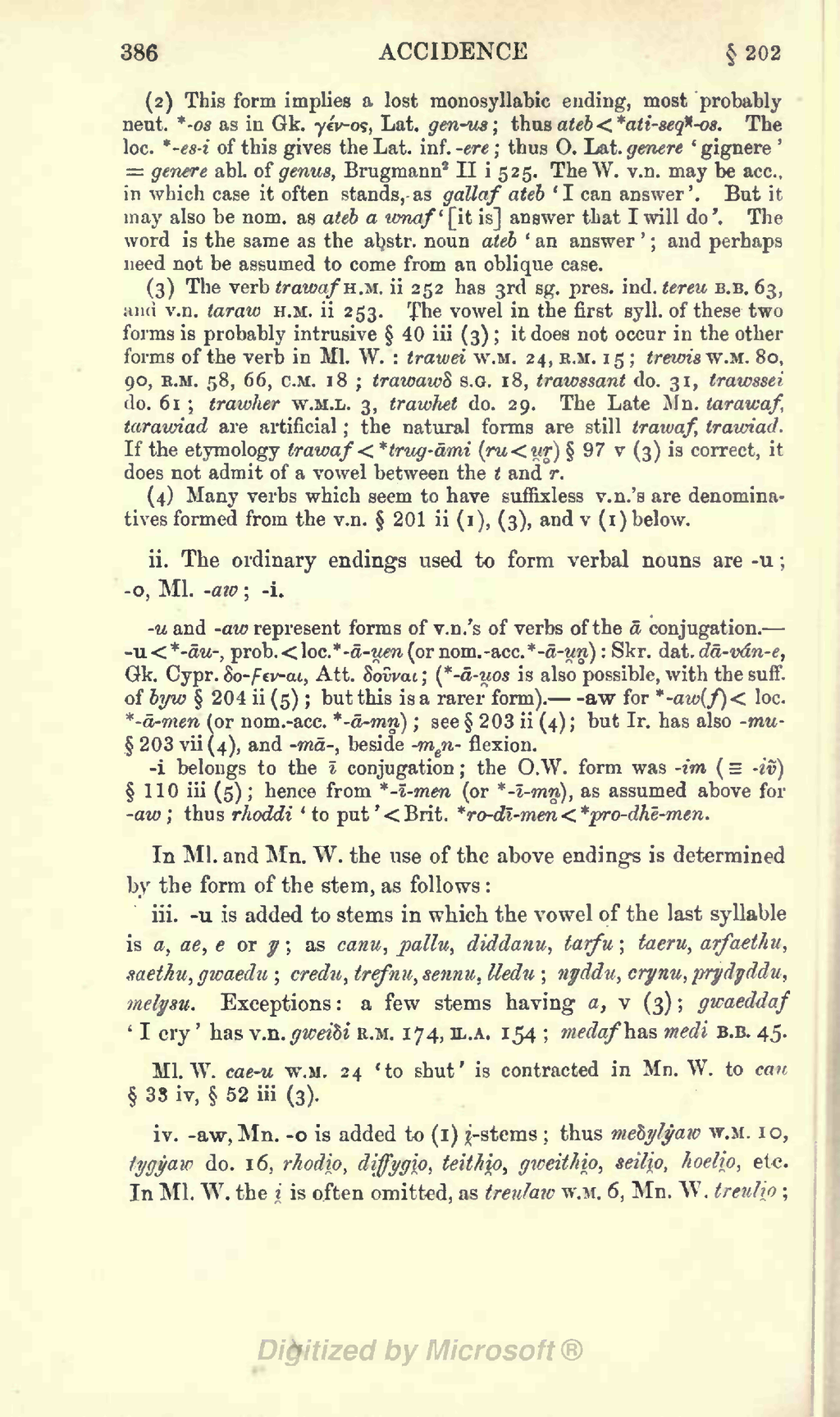(2) This form implies a lost monosyllabic ending, most probably neut. *-os as in Gk. γέν-ος, Lat. gen-us; thus ateb < *ati-seg*-os. The loc. *-es-i of this gives the Lat. inf. -ere; thus O. Lat. genere ‘gignere’ = genere abl. of genus, Brugmann² II i 525. The W. v.n. may be acc., in which case it often stands, as gallaf ateb ’I can answer’. But it may also be nom. as ateb a wnaf ‘[it is] answer that I will do’. The word is the same as the abstr. noun ateb ‘an answer’; and perhaps need not be assumed to come from an oblique case.
(3) The verb trawaf HM. ii 252 has 3rd sg. pres. ind. tereu B.B. 63, and v.n. taraw H.M. ii 253. The vowel in the first syll. of these two forms is probably intrusive 40 iii (3) ; it does not occur in the other forms of the verb in Ml. W. : trawei W.M. 24, B.M. 15 ; trewis W.M. 80, 90, H.M. 58, 66, C.M. 1 8 ; trawawS s.G. 18, trawssant do. 31, trawssei do. 6 1 ; trawher W.M.L. 3, trawhet do. 29. The Late Mn. tarawaf, tarawiad are artificial ; the natural forms are still trawaf, trawiad. If the etymology trawaf < *trug-ami (ru<ur] 97 v (3) is correct, it does not admit of a vowel between the t and r.
(4) Many verbs which seem to have sufiixless v.n.'s are denomina- tives formed from the v.n. 201 ii (i), (3), and v (i) below.
ii. The ordinary endings used to form verbal nouns are -u ; -o, Ml. -aw ; -i.
-u and -aw represent forms of v.n.'s of verbs of the a conjugation. -u < *-au-, prob. < \oc.*-a-uen (or nom.-acc. *-a-un) : Skr. dat. da-vdn-e, Gk. Cypr. 80- f ev-ai, Att. Sowcu ; (*-a-uos is also possible, with the suff.
of byw 204 ii (5) ; but this is a rarer form). aw for *-aw(f]< loc.
- -a-men (or nom.-acc. *-a-mn) ; see 203 ii (4); but Ir. has also -mu-
203 vii (4), and -ma-, beside -m e n- flexion.
-i belongs to the I conjugation ; the O.W. form was -im ( = -iv) 110 iii (5) ; hence from *-i-men (or *-l-mn), as assumed above for -aw ; thus rhoddi ' to put' < Brit. *ro-di-men<*pro-dhe-men.
In Ml. and Mn. W. the use of the above endings is determined by the form of the stem, as follows :
iii. -u is added to stems in which the vowel of the last syllable is a, ae, e or y ; as canu, pallu, diddanu, tarfu ; taeru, arfaethu, saethu, gwaedu ; credit, trefnu, sennu, ttedu ; nyddu, crynu, prydyddu, melysu. Exceptions : a few stems having a, v (3) ; gwaeddaf ' I cry ' has v.n. gweibi R.M. 174, IL.A. 154 ; tnedafbas medi B.B. 45.
Ml. W. cae-u W.M. 24 c to shut' is contracted in Mn. W. to caw 38 iv, 52 iii (3).
iv. -aw, Mn. -o is added to (i) j-stems ; thus mebylyaw W.M. 10, tygyaw do. 16, rhodio, diffygjo, teitfiip, gweitJiip, seilio, hoelio, etc. In Ml. W. the i is often omitted, as treufaw W.M. 6, Mn. \V. treulio;
